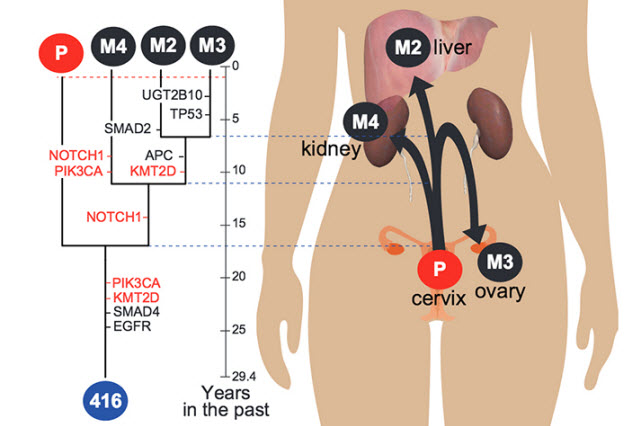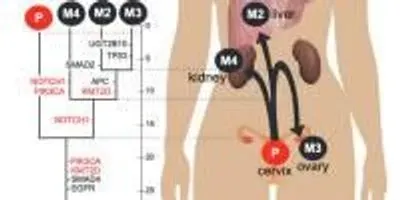 DNA sequencing demonstrated how cancer evolved from a primary tumor in the cervix to metastases in the kidney, liver, and ovary of a patient.Image courtesy of Yale University
DNA sequencing demonstrated how cancer evolved from a primary tumor in the cervix to metastases in the kidney, liver, and ovary of a patient.Image courtesy of Yale University
A novel Yale University study answers age-old questions about how cancers spread by applying tools from evolutionary biology. The new insights will help scientists better understand the genetic origins of tumor metastases, and lead to more effective targets for treatment, said the researchers.
The study, led by associate professor of public health (biostatistics) Jeffrey Townsend, was published on Feb. 8 by the .
Scientists have long thought that cancer is an evolutionary process that involves cells acquiring mutations that replicate and persist over time, gaining an advantage over normal cells. But questions remained about the timing and course of tumor progression.
To illuminate the process, the Yale team sequenced normal, primary, and metastatic tumor tissue from multiple individuals, including subjects with a range of cancer types. Applying the latest methodologies from evolutionary biology, the researchers mapped genetic mutations on the “tree” of cancer evolution occurring within each patient. Much like maps of species evolution, their analysis revealed genetic relationships and tumor chronology.
The researchers then confirmed three properties of cancer: First, they determined that metastases originate along different paths, or lineages, within primary tumors, and spread in a “branched,” rather than a linear, model.
“There are a lot of genetic differences within tumors,” said Townsend, “and different mutations appear in different metastases.”
Second, they found that metastases can genetically diverge from primary tumors early in cancer history. “We show that metastatic lineages separate very early on in the development of the cancer,” noted Townsend, who is also a researcher at Yale Cancer Center. This divergence can occur long before a primary tumor is diagnosed.
The team also demonstrated that major “driver mutations”—mutations that give a selective advantage to new mutations—are often mutated before the metastatic lineages diverge. “The major known cancer driver genes are often mutated in the primary tumor and all metastases, and successfully targeting them in therapy could provide widespread therapeutic benefit,” said Townsend.
This understanding of cancer’s evolution has key implications for treatment, he noted, “In addition to pointing out that we will need to target driver genes that are mutated early in cancer, this evolutionary approach provides a method that accurately characterizes which genes are being mutated early and late. That is extremely useful in terms of prioritizing which mutations should be targeted in order to produce therapies that are going to work.”
The study also provides oncologists with new insights to fight cancer. “Tools and theories that have been developed in evolutionary biology have utility for understanding cancer,” Townsend added. “Because we now know cancer simultaneously evolves along multiple trajectories, the oncologist of the future is going to have understand evolutionary biology in order to outmaneuver the disease.”
Additional authors include Zi-Ming Zhao, Bixiao Zhao, Yalai Bai, Atila Iamarino, Stephen G. Gaffney, Joseph Schlessinger, Richard P. Lifton, and David L. Rimm.
Advanced Lab Management Certificate
The Advanced Lab Management certificate is more than training—it’s a professional advantage.
Gain critical skills and IACET-approved CEUs that make a measurable difference.
This project was supported by Gilead Sciences, Inc.












